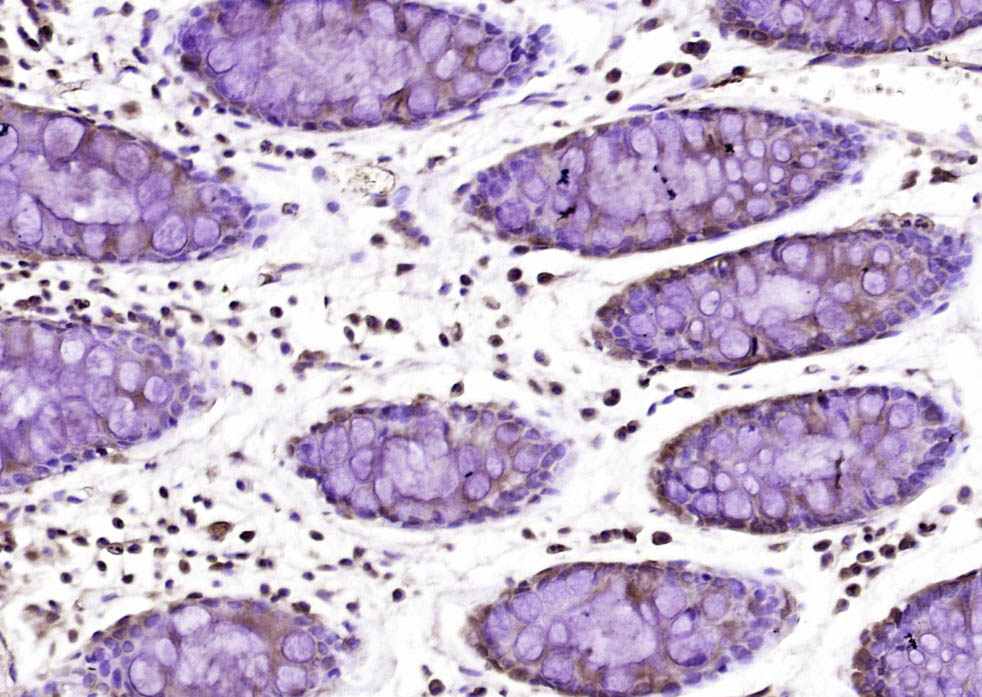
Rabbit Anti-OSMR antibody
Oncostatin M receptor; Oncostatin M specific receptor subunit beta; Interleukin-31 receptor subunit beta; IL-31 receptor subunit beta; IL-31R subunit beta; IL-31R-beta; IL-31RB; Oncostatin-M-specific receptor, beta; OSMRB; MGC140467; MGC150626; MGC150627;
View History [Clear]
Details
Product Name OSMR Chinese Name 抑瘤素M受体抗体 Alias Oncostatin M receptor; Oncostatin M specific receptor subunit beta; Interleukin-31 receptor subunit beta; IL-31 receptor subunit beta; IL-31R subunit beta; IL-31R-beta; IL-31RB; Oncostatin-M-specific receptor, beta; OSMRB; MGC140467; MGC150626; MGC150627; MGC75127. Research Area Tumour Cell biology immunology transcriptional regulatory factor Immunogen Species Rabbit Clonality Polyclonal React Species Human, Applications IHC-P=1:100-500 IHC-F=1:100-500 ICC=1:100-500 IF=1:100-500 (Paraffin sections need antigen repair)
not yet tested in other applications.
optimal dilutions/concentrations should be determined by the end user.Theoretical molecular weight 111kDa Cellular localization The cell membrane Form Liquid Concentration 1mg/ml immunogen KLH conjugated synthetic peptide derived from human OSMR: 571-670/979 <Extracellular> Lsotype IgG Purification affinity purified by Protein A Buffer Solution 0.01M TBS(pH7.4) with 1% BSA, 0.03% Proclin300 and 50% Glycerol. Storage Shipped at 4℃. Store at -20 °C for one year. Avoid repeated freeze/thaw cycles. Attention This product as supplied is intended for research use only, not for use in human, therapeutic or diagnostic applications. PubMed PubMed Product Detail Oncostatin M is a member of the IL6 family of cytokines. Functional receptors for IL6 family cytokines are multisubunit complexes involving members of the hematopoietin receptor superfamily. Many IL6 cytokines utilize gp130 as a common receptor subunit. OSM binds to the gp130 receptor subunit and, in association with the leukemia inhibitory factor receptor, induces a proliferative response in permissive cells. OSMR is an alternative subunit (for an OSM receptor complex (a heterodimer of gp130 and OSMR) that is activated by OSM but not by LIF.
Function:
Associates with IL31RA to form the IL31 receptor. Binds IL31 to activate STAT3 and possibly STAT1 and STAT5. Capable of transducing OSM-specific signaling events.
Subcellular Location:
Membrane.
Tissue Specificity:
Expressed at relatively high levels in all neural cells as well as fibroblast, epithelial and a variety of tumor cell lines.
DISEASE:
Amyloidosis, primary localized cutaneous, 1 (PLCA1) [MIM:105250]: A primary amyloidosis characterized by localized cutaneous amyloid deposition. This condition usually presents with itching (especially on the lower legs) and visible changes of skin hyperpigmentation and thickening that may be exacerbated by chronic scratching and rubbing. Primary localized cutaneous amyloidosis is often divided into macular and lichen subtypes although many affected individuals often show both variants coexisting. Lichen amyloidosis characteristically presents as a pruritic eruption of grouped hyperkeratotic papules with a predilection for the shins, calves, ankles and dorsa of feet and thighs. Papules may coalesce to form hyperkeratotic plaques that can resemble lichen planus, lichen simplex or nodular prurigo. Macular amyloidosis is characterized by small pigmented macules that may merge to produce macular hyperpigmentation, sometimes with a reticulate or rippled pattern. In macular and lichen amyloidosis, amyloid is deposited in the papillary dermis in association with grouped colloid bodies, thought to represent degenerate basal keratinocytes. The amyloid deposits probably reflect a combination of degenerate keratin filaments, serum amyloid P component, and deposition of immunoglobulins. Note=The disease is caused by mutations affecting the gene represented in this entry.
Similarity:
Belongs to the type I cytokine receptor family. Type 2 subfamily.
Contains 4 fibronectin type-III domains.
SWISS:
Q99650
Gene ID:
9180
Database links:Entrez Gene: 9180 Human
Omim: 601743 Human
SwissProt: Q99650 Human
Unigene: 120658 Human
Unigene: 658389 Human
Product Picture
References (0)
No References
Bought notes(bought amounts latest0)
No one bought this product
User Comment(Total0User Comment Num)
- No comment



 +86 571 56623320
+86 571 56623320
 +86 18668110335
+86 18668110335

